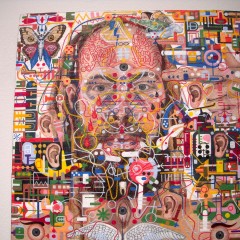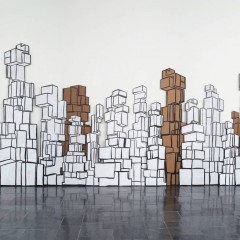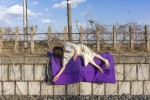This exhibition inaugurated Sue Spaid’s directorship at the Contemporary with a bang and a guffaw (and quite a few chuckles). LOL; A decade of antic art was a tightly-packed survey of artists or collaboratives whose work during the past decade involved satire, parody and pranks which ranged from engaged political seriousness to everyday fun. The exhibition ran from June 10-Sept. 4, 2011, and I apologize for getting there the final weekend, which makes this review retrospective. It was well worth the100-mile trip from Philadelphia.

Spaid defines Antic Art as work that engages the ordinary passersby, who become unwitting participants in humorous and surprising situations and acknowledges that exposing this genre in the context of a “museum survey” risks eliminating the volatility characteristic of the genre. The context certainly compromised the humor (if not volatility) of a number of pieces, which like so much humor, was dependent upon the element of surprise or the unexpectedness of the situation. For other works which were presented as documentation, the problem was rather like reading restaurant reviews: they give you an idea of the food, but none of the actual pleasure of eating it. Still, in a period when many curators take the easy way out and organize one monographic exhibition after another, it is refreshing to find a someone willing to take on a thematic exhibition, even when she’s well aware of the risks. And it was a good introduction to a lot of smart work.
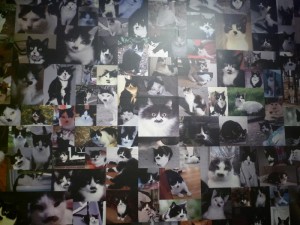
Some pieces were intended to be viewed in galleries or as filmed documentary and successfully brought all their humor indoors. Nina Katchadourian worked with Mark Tribe and Steven Matheson, MFA students from UCSD, to arrange Carpark at Southwestern College. On a specified day they directed all the drivers on campus to park in separate lots, designated by the color of the cars. The film of the event recorded the earnest or amused compliance of most drivers, annoyed resistance of a few, and the nightly tv news coverage of the project, which brought humor as well as a rare measure of aesthetic interest to one of the blights of the modern environment.
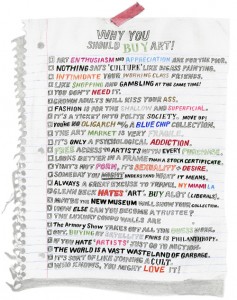
Humor in other works arose from the tension between believing the artist’s description and questioning it, or the assumptions upon which it was based. Did Rob Pruitt really find all those photographs of cats sporting Hitler mustaches on the internet? Could he have been obsessive enough to have set up all those photos himself? And why would anyone do that? Gimhongsok toyed with the liberal political leanings of his audience for Bunny’s Sofa; the label stated that the Harvey-sized rabbit on the couch was actually a costume being worn by an illegal North Korean immigrant paid sub-minimal wages to appear before us. We might guess there wasn’t a large pool of illegal North Koreans in Baltimore, but the bunny was certainly large enough to conceal a man. Did it?
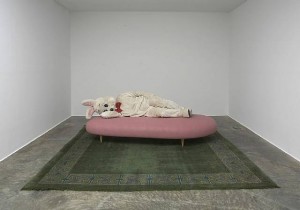
Two short animations by Jennifer Levonian were as delightful as all of her stop-take animations created with articulated watercolor drawings. Buffalo-Milk Yogurt was a send-up of food-obsessed yuppies who find self-righteousness in their shopping choices at Whole Foods. The nude woman meditating in a cross-legged, yoga position as she sits on a pile of pumpkins in front of the store was only a tad more absurd than the reality.
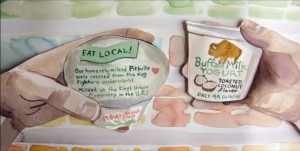
My hands-down favorite was the video of a performance by the Russian collective Chto Delat? (What is to be Done? The term is from Lenin). Tower; a Songspiel (a songspiel is a musical theater piece) is a bitter satire about former Soviet power brokers forced to adapt their rhetoric to the changed situation of an ostensibly democratic and capitalist Russia. It shows a group of the elite examining the model of the Gazprom tower, planned for St. Petersburg and slated to be the tallest building in Europe. Anticipating resistance, one of the group cautions not to suppress the journalists (as in the past) – it’s better to buy them off, he cautions.
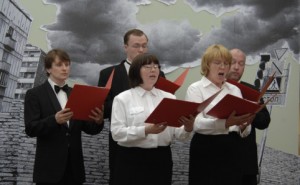
The madcap video, part Brecht and part Monty Python, skewers the idea of a nationalist art and the Romantic notion of artistic production as well as the eternal mendatiousness of Russia’s leaders. The visuals are high-concept and the production standards thoroughly professional; this is not Samizdat art cobbled from scavenged materials. These artists are fighting for their lives and the soul of the Russian people – if it still exists, which gives their work a bitter but extremely compelling edge that nothing else in the exhibition matched.
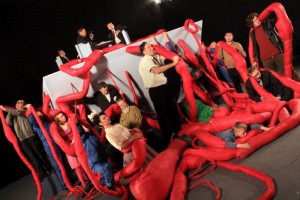
Also included in the exhibition were: Kendall Bruns, Kahty Chen Milstead, Patrizia Giambi, Larry Hammerness, Jonathan Horowitz, Katie Kehoe, Larry Krone, Ryan Mulligan, My Barbarian, Dan Perjovschi/Nedko Solakov, David Schafer, Alysse Stepanian/Philip Mantione, Joey Versoza and the Yes Men!


